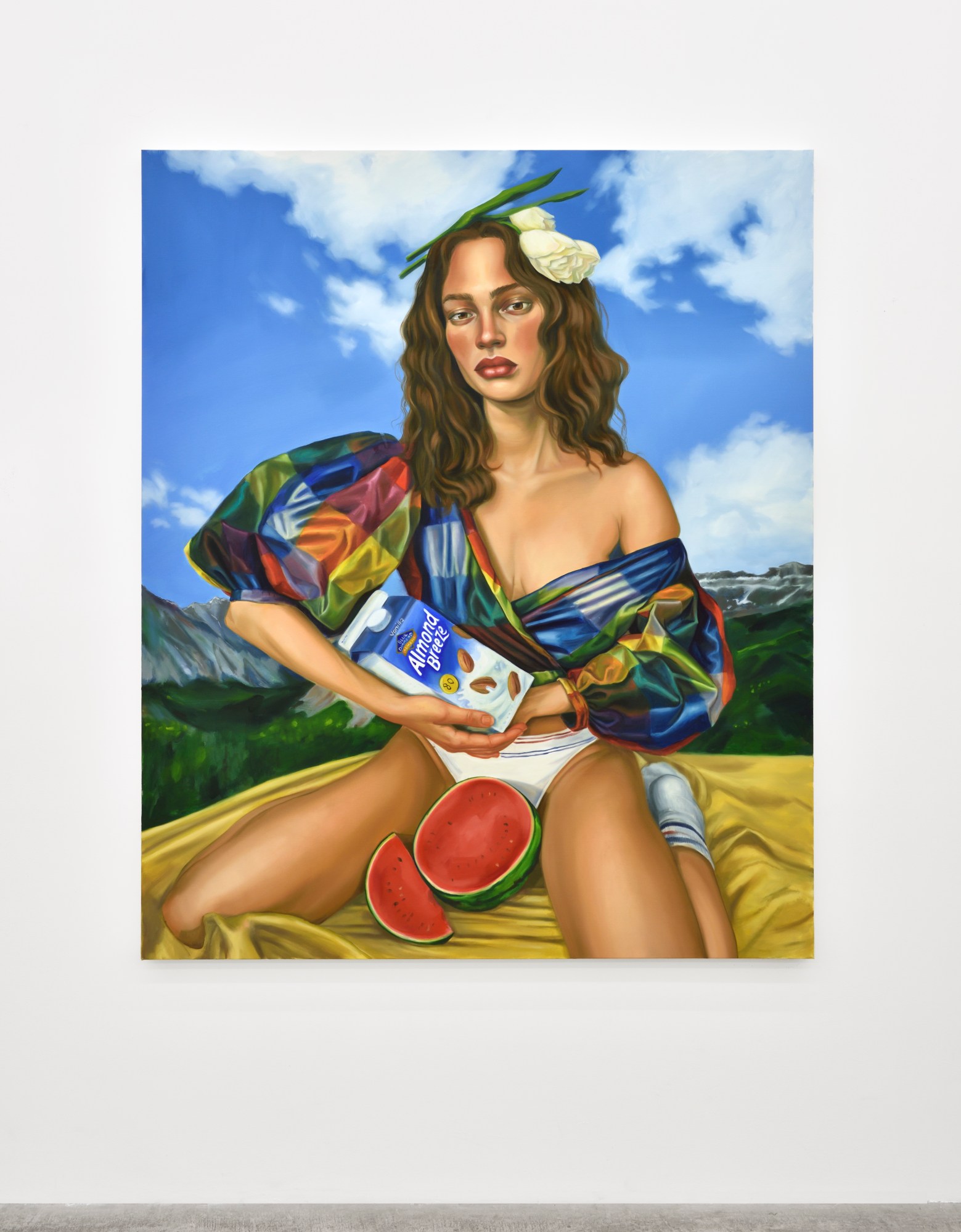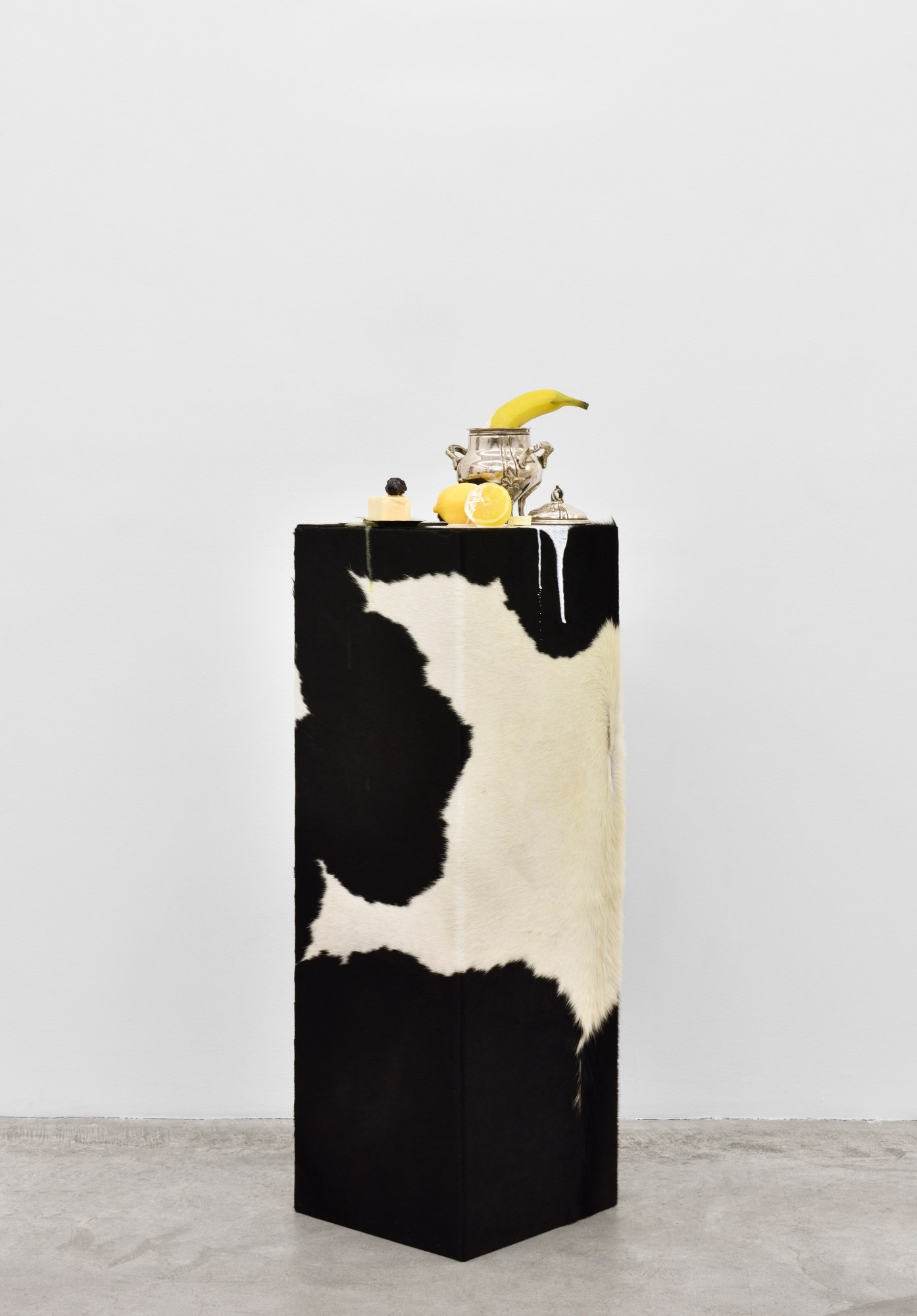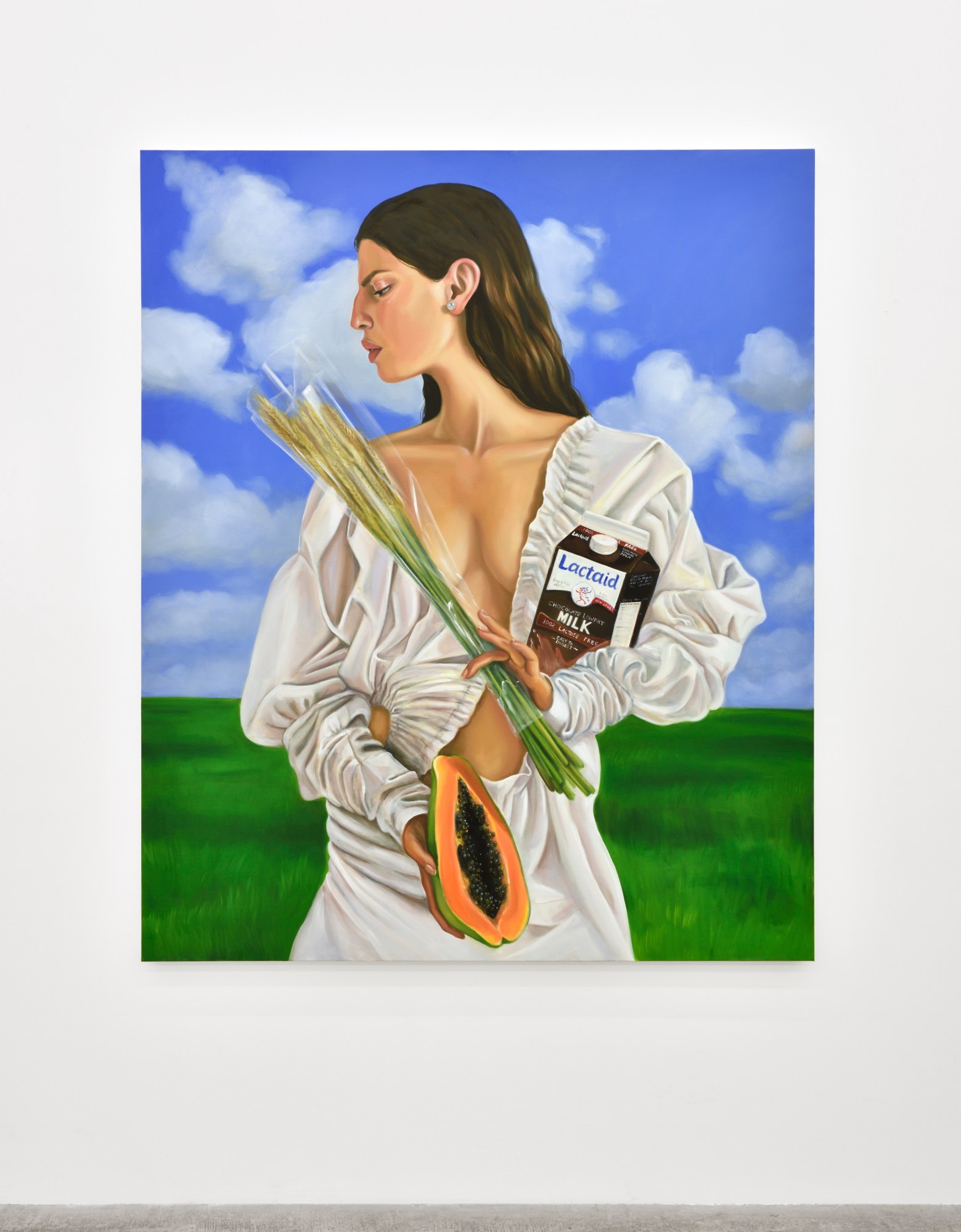Chloe Wise’s work is as much about playfulness as provocation. The Canadian-born, New York-based artist uses an approach that is, as New York magazine recently put it, “glamorous or gross or funny or all three.” And the new pieces on display at her current show in Paris, Of False Beaches and Butter Money, are no exception.
The work confronts clichés of American gluttony and the fetishization of food. It’s very Katy Perry in full “Bon Appétit” splendor (“got me spread like a buffet…”) with perhaps a dash of La Leche League. Wise reworks traditional modes of portraiture, capturing female sitters clasping ranch dressing and almond milk. Classical still-life scenes become live installations, a stylized bounty on mirrored surfaces or cow hides, with ensembles of fake fruit and wedges of cheese doused with rivulets of runny cream.
Satirizing milkmaid paragons, pastoral fantasies, and obsessions with consumption, Wise blurs the kitsch with the critical. She spoke to us about Pop Art, the moral ambiguities of being a carnivore, and cross-cultural perceptions of dairy.
Why is food a compelling topic to explore? Is this theme in your work related to the current craze for health-conscious eating?
I use food to explore issues that are not necessarily related to it, such as sexuality, identity, class, and gender. So many of these topics can be unpacked through mundane aspects of our lives. The movement towards health-conscious eating is a hilarious point of departure for me, because I certainly subscribe to this, and I also love/hate the modes of advertising associated with it. I’m highly critical of the inconsistencies that can be found if you scratch the surface of the healthy food industry. For example, quinoa literally deforests South America — but is deemed a superfood, so it allows us a “moral, green life.” I think that we can examine social construction through these habits.

There’s a sense of skewering traditional art history genres in your work. How do classical tropes influence your aesthetic?
I’m very moved by the works by Sargent, Waterhouse, and Lucian Freud. My current show has a lot of references to Vermeer and other classical Dutch Golden Age painters. Right now I’m really fascinated by [Dutch artist Cornelis] Pronk, for his ostentatious still life images.
Can you elaborate on the title of the show, Of False Beaches and Butter Money ?
There is a saying in French “vouloir le beurre, l’argent du beurre, et le cul de la crémière,” which translates to “to want the butter, the butter money, and the milkmaid’s ass,” which is equivalent to “wanting to have your cake and eat it too.” It pertains to the exhibition’s milkmaid imagery, but also the idea of somebody wanting it all. It encapsulates our consumer desires and our simultaneous desire to live our lives with morality — but these two desires often are at odds with each other. My show speculates on the cognitive dissonance that takes place when we objectify meat and dairy products. They lose their “living creature”-ness, to allow us to consume them without feeling as if we acted immorally. If we say, “I’ll have the beef, please,” as opposed to, “I’ll have the cow corpse, please,” we are using language that creates a moral boundary between the reality of the thing we are eating and the thing we have decided is OK to consume.
Additionally, Picasso has a lot of amazing poetry that I have been reading. He repeats the line “false as a beach” multiple lines, which I love because it implies the role of fiction in our ideas and assumptions of paradise.
There’s also so much humor in your work. What makes you laugh?
Kittens on Instagram.
Who do you think uses humor well in their art?
Cindy Sherman, Tom Wesselmann, and Ryan Trecartin.
How do branding and logos function in your work? In this series alone, there’s a Shell baseball cap, Splenda, Lacroix cans, and cartons of Lactaid.
I think brands and their logos come to represent a set of visual cues and authorities that we accept, and even welcome, as consumers. We create and manifest our individuality based on a number of elements, but many of them pertain to our consumptive habits. So when we buy branded items, we are adding them to our inventory of “things I associate myself with.” I’m really interested in ideas of identity formation via consumption. Even if we choose to not participate, that choice informs our sense of self. Also, I think a lot about Warhol and Claes Oldenburg, and the Pop artists’ use of iconic grocery store items is an important part of the dialogue. Branding functions as a silent but constant conversation.

There’s a very different approach to food culture in France, where you’re showing, compared to America, where you’re producing. Do you think that will have any effect on how your work is perceived?
I’m excited to explore the imagery of the milk industry because its very nature capitalizes off different narratives, depending on who it is being sold to. In the USA, we are currently witnessing a widespread fear of dairy due to the popularity of lactose-free beverages and a realization that, yeah, milk is kinda gross! So I’m interested in the imagery that comes along with these new products. In Europe and France, the dairy culture has more of a history, and I think there is some beautiful imagery that comes with that. But there is also an attachment to wholesome milk symbols, even though in reality these are very far removed from the products that end up on the shelves. My exhibition contains elements that relate to both of these ways of seeing dairy: as something abject and gross, and as something wholesome and beautiful. The moment of friction between two ways of seeing anything is what interests me.
How do states of undress fit with this idea of appetite? How does sex and nudity play into this series of portraits?
The way food is advertised to us capitalizes on our systems of desire, which often tap into our sexual appetite. Often, the imagery and language of both of these seemingly disparate desires are conflated. Advertising uses sex to sell just about anything, so we are used to seeing gendered or sexualized foods.
Who sits for your portraits, and what are those sessions like?
Friends. I take photos on my phone, or if I’m somehow feeling organized (rare) I ask a real photographer friend to take a photo. I cover my friend-model in coconut oil and take photos of them being shiny and gorgeous.
Does the political climate in America shift the way you want to depict and discuss women?
Yes, it brings on a quite urgent feeling and need to express resistance: to bring up topics that are meaningful to us, to be loud, to be heard, and to represent bodies that are marginalized to begin with, but will be even more so with the current climate.
I read that you title your paintings from a list of funny sentences uttered by you or your friends that you keep on your iPhone. Any recent gems?
It’s a mixture of overheard phrases, lyrics, things misheard, funny quotes from packaging — it depends. Some titles from my new exhibition: “My sad heart and your stiff nipples at the Biennale,” “Heaven is for history,” “Visions of soft skin, Tabasco sauce.”
“Of False Beaches and Butter Money” is at Almine Rech Gallery in Paris.
